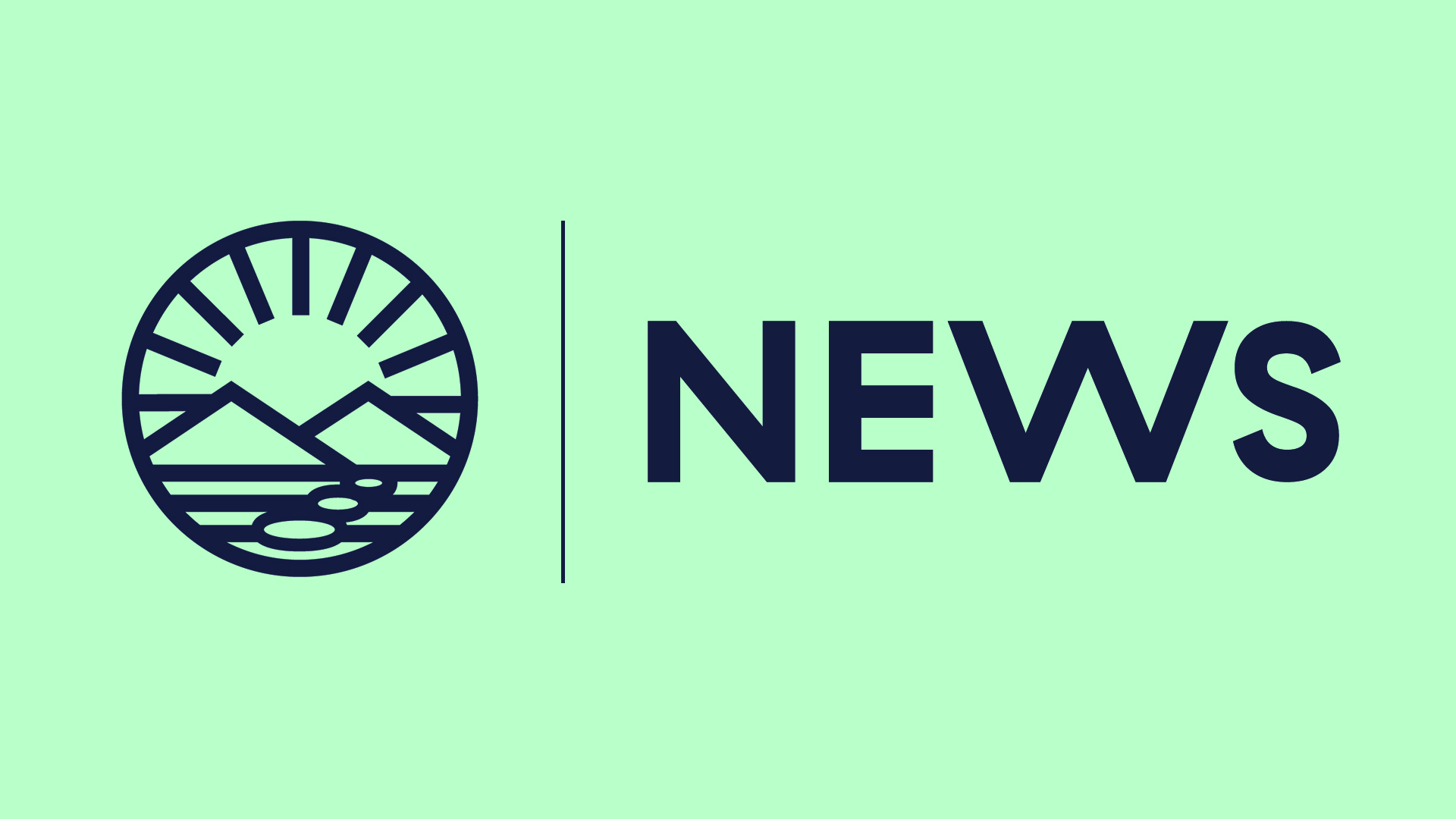CAMPBELL RIVER, BC – As salmon farming licences held by B.C.’s salmon farming sector expire at the end of June 2024, Fisheries and Oceans Canada (DFO) has an opportunity to thoughtfully consider the reissuance in light of transition commitments. While past performance related to impacts and incidental catch is important context, the situation has evolved significantly in recent years through new agreements, standards and technologies aimed at minimizing interactions and risks to wild Pacific salmon.
“Over the past 20 years, salmon farming companies on the coast of British Columbia have made substantial progress in minimizing incidental catch and environmental impacts and engaging with First Nations through innovations, new technology and collaborations,” says Brian Kingzett, Executive Director of the BC Salmon Farmers Association. “Strict government regulation and third-party certification ensure farming practices protect wild salmon and other wildlife .”
Notable innovations include:
- Groundbreaking agreements with rightsholder First Nations in whose territories we operate.
- Third-party certification to international standards such as the Global Seafood Alliance Best Aquaculture Practices (BAP). Farms must demonstrate strong performance in key areas like environmental impact, predator and wildlife interactions, and animal health and welfare.
- Drastically tighter licence conditions directly address issues like predator interaction protocols, lighting use, parasite/disease testing and reporting of all mortalities. Non-compliance faces strict penalties.
- Innovative new technologies aimed at further reducing potential impacts. For example, some farms now use marine mammal exclusion devices and LED lights exclusively within farm boundaries.
- The total incidental catch for the sector is low. Comprehensive data shows interactions represent a small fraction of overall harvest catches in coastal fisheries and populations. For example, incidental catches of herring represented less than 0.014% of herring catches over the last decade (see table 1 below) .
It is acknowledged that concerns remain; however, data shows impacts are low and wildlife populations remain healthy according to the best available science. With new agreements and strict regulations now in place, the path forward must thoughtfully consider both environmental and socio-economic priorities to achieve balanced outcomes for all.
While past impacts must not be overlooked, the situation has improved through cooperation between First Nations, government and industry. DFO now has a real opportunity to provide stable conditions supporting ongoing progress through thoughtful, evidence-based licensing decisions. With so many coastal livelihoods at stake, achieving balance is critical to transitioning in an economically and environmentally responsible manner.
“Everyone working on the oceans must take care to minimize impacts from their business, whether it be shipping, tourism, commercial and sport fisheries, or aquaculture,” says Kingzett. “The aquaculture sector – working with First Nation partners and third-party experts – takes this responsibility very seriously and, learning from past interactions with wildlife, has been implementing new technologies and methods that effectively reduce or eliminate impact on wildlife.”
ABOUT THE BC SALMON FARMERS ASSOCIATION
BC salmon farmers are committed to reconciliation, and all farms operating in BC are currently done in agreement, negotiation, or established partnerships with First Nations in whose territories we operate. These agreements are founded upon recognizing First Nations’ right to exercise jurisdiction over the land, resources, and waters within their territories.
Farm-raised salmon generates over $1.2 billion for the provincial economy supporting thousands of jobs. Additionally, farm-raised salmon provides a nutritious and sustainably produced protein with a low carbon footprint that contributes to Canada’s food security and Blue Economy.
The BC Salmon Farmers Association represents over 60 businesses and organizations throughout the value chain of finfish aquaculture in BC. Our members account for over 95% of the annual provincial harvest of farm-raised salmon in British Columbia.
For more information, visit bcsalmonfarmers.ca.
MEDIA CONTACT
Michelle Franze
Manager of Communications, Partnerships and Community
michelle@bcsalmonfarmers.ca
604-202-4417
MISINFORMATION REGARDING BC SALMON FARMING INCIDENTAL CATCH
“Open net-pen technology is antiquated, having changed little since the 1970s.”
Salmon farming has experienced rapid innovation since it started in the 1980s. For example, changes have been made to the entire regulatory framework, First Nation agreements, dietary improvements, feed efficiency, feeding equipment, training and practices, veterinary practices, cage and anchoring design, pen design, in-feed cameras, digital advances, staff training, brood selection, sea lice treatments, benthic monitoring.
“They deposit huge quantities of fish feed in the water.”
Feed formulations and feeding practices have improved enormously over the years. It now takes about 1.15 to 1.2 kilograms of feed to produce 1 kilogram of farm-raised salmon. The deposition of nutrients and organic matter, such as fish fecal matter and uneaten feed, is now about 5% of the administered feed. Further advancements in camera-assisted feeding control and acoustic registration of lost feed pellets have reduced feed loss to about 3%.
“And they regularly have dead fish floating or at the bottom of the nets.”
Routine collection and disposal of any mortalities is a requirement of the Conditions of License.
“All these attract fish and wildlife and as a result, many are killed by the industry.”
Excluding a single increase in herring incidental catch in 2022, incidental catch on salmon farms is low; largely because farmers have minimized attractants and excluded access to the pens (see figure 1).
In 2012, BC salmon farmers implemented a sector-wide management policy for seals and sea lions that included the implementation of mandatory prevention measures and a no-kill policy. This was four years before DFO instituted their no permitted authorized euthanasia policy (see figures 2 and 3 .
“There have been a number of incidents of humpbacks injured, trapped, found dead or killed in association with salmon farms and their equipment.”
While this has occurred, the sector responded with operational changes to mooring lines. There have been no deaths since 2016. Additionally, humpback whale populations are on the rise in BC, with an estimated population of 12,460 as of 2018.
“Yet, in 1993 factory fish farms in the Broughton Archipelago installed high-amplitude acoustic harassment devices”
Underwater acoustical deterrents are not permitted in BC.
“Of all B.C. mammals killed at salmon farms, seals and sea lions have taken the biggest hit.”
Seals and sea lion populations are rapidly rising in BC, yet salmon farming measures are working to keep seals and sea lions safe.
Table 1. Incidental catch mortalities at salmon farms in BC compared to the total commercial capture fishery (pacific herring, pacific herring spawn biomass, groundfish, salmon) from 2011 to 2021/2022
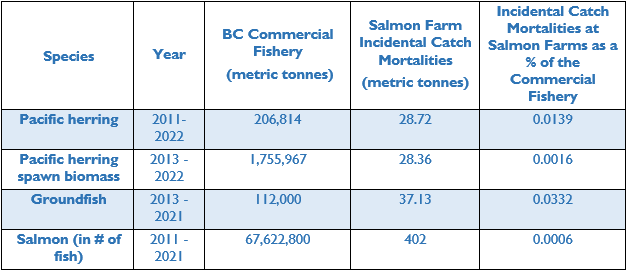
Source: DFO Incidental catch at BC marine finfish aquaculture sites
https://open.canada.ca/data/en/dataset/0bf04c4e-d2b0-4188-9053-08dc4a7a2b03
–
Figure 1. Incidental catch mortalities at BC salmon farms by fish category (2011 to 2022)
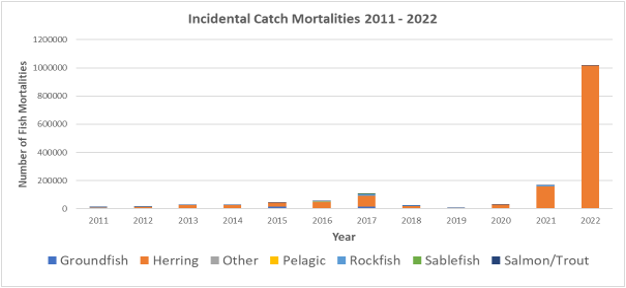
Source: Government of Canada Open Data website Note that groundfish total excludes rockfish and sablefish, and pelagic excludes herring and salmon/trout
https://open.canada.ca/data/en/dataset/0bf04c4e-d2b0-4188-9053-08dc4a7a2b03
–
Figure 2. California sea lion mortalities at BC salmon farms from 2011 to 2022
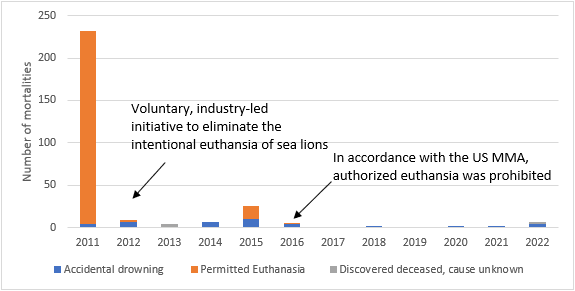
Source: DFO Open Data.
https://open.canada.ca/data/en/dataset/a7b3fdfb-5917-4ca6-b29c-093e3f65d6ba
–
Figure 3. Harbour seal reported mortalities from 2011 to 2022.
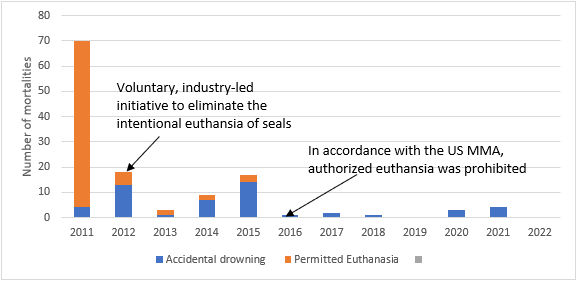
Source: DFO Open Data.
https://open.canada.ca/data/en/dataset/a7b3fdfb-5917-4ca6-b29c-093e3f65d6ba
–
